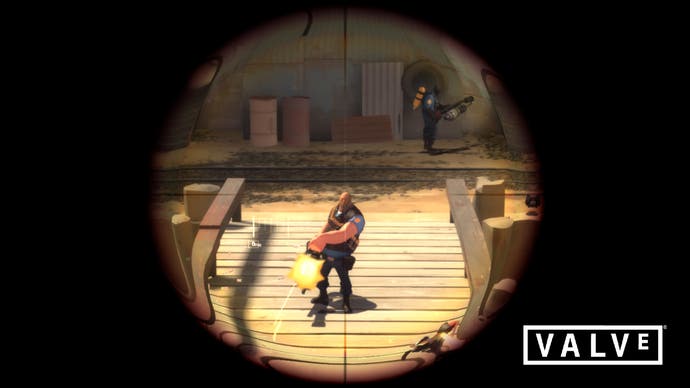Team Fortress 2
King of the castle.
Thanks to failing eyesight (thanks, Suicide Girls) and this newfangled obsession with making everything look gritty, online FPS games are harder for me than ever. Half the time I can't pick people out from the environment until it's too late. Even in Counter-Strike, which is clearer than most, I often get popped in the head by a distant Colt and then have to cycle the chase-cameras to work out who killed me and from where.
So it's important to start this review by jumping up and down waving excitedly about Team Fortress 2's brilliant graphics: not only is everything extremely clear and intuitive, with character classes that you can easily distinguish at distance, but when you get killed the game crash-zooms to and freeze-frames your killer, so you can immediately identify who, why, how and where. Other FPS developers: copy this immediately.
Making a complicated team-based online FPS like Team Fortress into an accessible experience was obviously one of Valve's objectives. Each map comes with a short video that tells you about the game-type and goals; all the level architecture is distinct when you move between sections, with big sign-posts telling you which capture-point or area you're heading to; and all the weapons and abilities are really intuitive, like the Medic's healing gun, which fires health into your target and illustrates this by pumping little red crosses along the stream.

Thankfully that doesn't mean TF has been dumbed down. There are nine classes, and, while several are easy to pick up, getting the most out of each will take hours of experimentation and intuition. The Spy, for example, perfectly captures the sense of the name. Armed with a flick-knife and the ability to disguise himself as the enemy, the Spy can infiltrate enemy bases and even make himself invisible. But he's fragile, and you can uncloak him by shooting or brushing against him. And while his flick-knife kills with one hit, it only does so from behind, and using it gives up his position.
Along with the Medic, Heavy Weapons Guy, Scout, Pyro, Sniper, Demo Man, Engineer and rocket-jumping Soldier, that makes nine classes, which you can pick from before each respawn. Your team's objective, depending on the map, may be to run the enemy off control-points or defend them, to capture and hold them in a tug of war, or simply to race into the enemy base and nick a briefcase of intelligence (so, CTF).

Again though, TF is accessible without feeling slight, and the key to that isn't the six maps, or the game-types, but those nine classes. Individually each has a trio of weapons and various specific attributes, like an amount of health and movement characteristics that are relative to the character's stature, as well as the occasional special ability.
Some classes, like the Soldier and the minigun-toting Heavy Weapons Guy, are easy to pick up and easy to integrate into a team with which you're not familiar. Slightly more skilled players, or those with TF experience, will happily slot into less glamorous or obvious roles like the Engineer, Demo Man or Pyro. The latter's flamethrower is great over short distances, but won't finish enemies off quickly, so you mousewheel to the shotgun for a killing blow, while the Demo Man is a mixture of high-impact projectiles and remote-detonation mine-launching, giving it offensive and defensive flexibility.

The Engineer also has that flexibility. As a support unit, the ammo- and health-dispensing stations it produces are great for maintaining forward positions, while the teleports it can set up help reinforce them. But these things are also important in defence, along with the all-powerful sentry guns, which completely disrupt an attacking team's momentum until they're cleared.
Engineers are particularly susceptible to Spies, though, because they're often kneeling down and working on something. And Spies are drawn to their location, because Spies can also undo entrenched sentry guns, sabotaging them at the potential cost of exposure. That relationship is typical. Each class is a cunning set of contradictions. It's not so much rock, paper, scissors as rock, paper, scissors, flick-knife, fire, sentry-gun, mini-gun, sniper rifle, double-jump, bone-saw.








